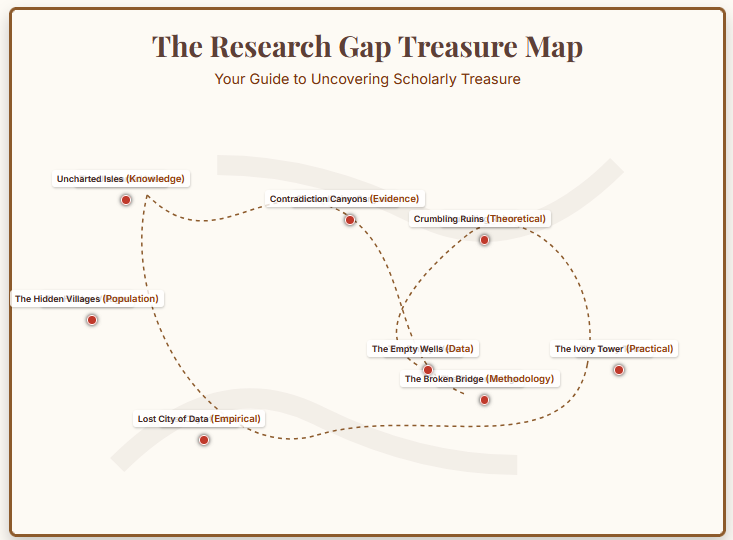The Researcher's Treasure Map: A Guide to Finding Your Research Gap
For every PhD student, the journey begins with a single, critical mission: to find the research gap. This is not just a box to tick; it is the very foundation of your work. It's the "X" on the intellectual treasure map that marks the spot where your unique contribution will be buried. Yet, for many, this task feels less like an adventure and more like staring at a blank, intimidating map.
But identifying a research gap isn't about finding something no one has ever thought of. It's a systematic process of understanding the current landscape of your field and recognising where it is incomplete, flawed, or in need of a new perspective.
This guide will reframe your search, transforming it from a daunting task into a strategic treasure hunt. We’ll explore the eight primary types of research gaps, not as a dry list, but as different kinds of treasure waiting to be discovered.
Part 1: Gaps of Exploration – Venturing into the Unknown
These are the gaps that exist in the uncharted territories of your field, where knowledge is sparse or non-existent.
- 1. The Knowledge Gap (The Uncharted Territory)
This is the most fundamental type of gap. It exists when there is little to no research on a particular topic or phenomenon. You are, in essence, the first explorer to plant a flag here.
- Why it Matters: This is your chance to pioneer a new area of inquiry, laying the groundwork for all future research.
- Example: Studying the long-term psychological effects of a brand-new technology that has never been researched before.
- 2. The Empirical Gap (The Unverified Theory)
This gap appears when a topic has been heavily discussed in theory, but lacks the real-world data to support or validate those theories. The ideas exist, but they have not yet been tested in the messy reality of the world.
- Why it Matters: Filling this gap allows you to test, confirm, or challenge existing theories, providing the crucial evidence needed to move a field forward.
- Example: A well-established economic theory has been widely debated, but no one has ever collected the specific real-world data to see if it holds true.
Part 2: Gaps of Critique – Challenging and Refining the Known
These gaps aren't about what's missing, but about what's flawed or incomplete in the existing literature.
- 3. The Evidence Gap (The Conflicting Findings)
This gap emerges when the existing research presents conflicting or inconsistent findings. One study says X, another says Y. The path forward is unclear, and your job is to be the tie-breaker.
- Why it Matters: Resolving these contradictions brings clarity to your field and helps establish a more reliable foundation of knowledge.
- Example: Different clinical trials report contradictory results on the effectiveness of a new drug.
- 4. The Methodological Gap (The Flawed Tools)
This gap arises when the methods used in previous studies are outdated, flawed, or simply not sophisticated enough to answer the question properly. You see a better way to measure or analyze the phenomenon.
- Why it Matters: Introducing a new or improved methodology can revolutionize a field, allowing for more reliable and nuanced findings.
- Example: Using a new imaging technique to study a biological process that was previously only observed with less precise methods.
- 5. The Theoretical Gap (The Incomplete Explanation)
This occurs when the existing theories used to explain a phenomenon are insufficient, one-sided, or outdated. You recognize that the current model doesn't fully capture the complexity of what's happening.
- Why it Matters: Proposing and validating a new theoretical framework can lead to a paradigm shift in how your field understands a topic.
- Example: A psychological phenomenon is still being explained by a theory from the 1950s that doesn't account for modern social factors.
Part 3: Gaps of Connection – Bridging and Broadening the Conversation
These gaps are about ensuring research is relevant, inclusive, and connected to the world it aims to serve.
- 6. The Practical-Knowledge Gap (The Theory vs. Practice Divide)
This gap highlights a disconnect between what academic theories propose and what happens in the real world. The research may be sound, but it isn't useful to the practitioners on the ground.
- Why it Matters: Bridging this gap ensures that research has a tangible, positive impact and solves real-world problems.
- Example: Widely published educational theories that teachers find impossible to implement in a real classroom setting.
- 7. The Population Gap (The Overlooked Communities)
This gap appears when a specific population or community is underrepresented or ignored in the existing literature. The "general" findings of a field may, in fact, only apply to a very specific group.
- Why it Matters: Addressing this gap makes research more inclusive, equitable, and generalizable.
- Example: The vast majority of studies on a particular health condition have only focused on urban populations, completely ignoring the experiences of rural communities.
Final Thoughts
Identifying a research gap is the first, most crucial step in your journey from student to scholar. It is your license to innovate, your justification for your work, and your opportunity to make a unique and lasting contribution to your field. By understanding these different types of gaps, you can move forward with the clarity and confidence of a seasoned explorer, ready to map your own territory.
Frequently Asked Questions (FAQ)
- How do I know if a research gap is significant enough for a PhD?
A significant gap is one that, if filled, would meaningfully advance the conversation in your field. Ask yourself: "If I answer this question, who would care? What would change?" Discuss potential gaps with your supervisor; their experience is invaluable in gauging the potential impact of a research project. - What is the difference between a Knowledge Gap and an Evidence Gap?
A Knowledge Gap exists where there is little to no information at all. You are truly starting from scratch. An Evidence Gap exists where there is information, but it is contradictory, inconsistent, or insufficient to draw a firm conclusion. You are entering an existing debate to bring clarity. - Where is the best place to find research gaps?
The "Future Research" section of recent, high-quality papers in your field is often a goldmine. This is where leading experts explicitly state what they believe are the most important unanswered questions.


